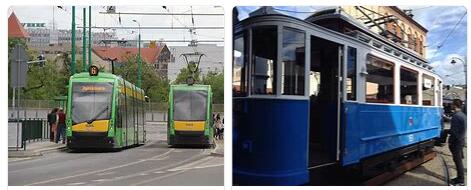Transportation in Poland

Airplane: LOT operates a nationwide network of domestic flights. There are daily flight connections between Warsaw and Gdansk, Bydgoszcz, Krakow, Katowice, Szcezcin, Lódz, Poznan, Zielona Gora, Rzeszów and Wroclaw. All regional flights go via Warsaw. Most airports are connected to the public transport network. Exceptions are Kattowice and Szczecin.
Ship: Poland has a long coastline and numerous rivers and canals. However, there is only a limited offer on passenger ships, and only during the summer months. There are no regular boat connections along the coast and the main rivers. Some cities, including Gdansk, Szczecin, Wroclaw, Krakow, Torun, Kolobrzeg and Poznan, offer local river cruises or sea excursions in the summer. There are also trips from Elblag to Frombork and to Krynica Morska. Excursion boats operate on the Masurian Sen in summer. There are also excursions on the Elblag-Ostróda Canal and the Augustow Canal.
Train: Trains are an important, comfortable and punctual means of transport, especially on long journeys. It can only get full during the holiday months of July and August. The rail network is operated by the Polish State Railways (Polskie Koleje Pa? Stwowe – PKP). The rail network in Poland is very extensive and reaches most places in the country. Only in the mountainous south of the country there are fewer connections.
Timetables (Rozk? Ad jazdy) are available at all train stations. The departure times (Odjazdy) are on white boards, the arrival times (Przyjazdy) on yellow boards. Normal trains are shown in black, express trains in red. The addition Ex also identifies express trains. InterCity trains are identified by the addition of IC. For trains marked with the letter R, a seat reservation is necessary. The additions kursuje and nie kursuje mean that a train runs or does not run at certain times of the day.
Tickets are available at the ticket counters in the train stations or from the conductors. There are ticket machines at many train stations.
There are three train categories in Poland: express, express and regional trains. Express trains (poci? G ekspresowy or ekspres) are the fastest and most convenient and only stop at major InterCity stations. Seats must be reserved when purchasing tickets. A luxurious variant of the express train is the InterCity (or for European traffic also the EuroCity). These trains run certain routes from Warsaw. The few stops include Gdansk, Katowice, Kraków, Poznan and Szczecin, among others.
Express trains (Poci? G pospieszny) stop at more intermediate stations and travel with them is much cheaper. A seat reservation is not required. Regional trains (Poci? G osobowy) are slower and stop at all stations along the route. These trains usually cover shorter distances. Almost all trains have first and second class cars. Some trains have sleeping cars.
Car / rental car: if you want to rent a car in Poland, you need a valid passport and credit card and have had your driving license for at least one year. The minimum age required by the rental car agencies is 21 or 23 years. For some luxury models you have to be older. As a rule, Polish rental cars are not allowed to be used for trips to other countries. Rental cars in Poland are expensive and there are rarely any discounts. It is cheaper to rent a car from abroad or via the Internet.
A good insurance for the vehicle and objects carried should be a prerequisite for trips to Poland with your own car. Car theft and organized crime can be a problem, especially in the larger Polish cities. Therefore, nothing should be left behind in a parked car. It is advisable to park the car in a guarded parking lot.
Bus: Overland trips by bus are provided by the Polski Express buses. Tickets are available at the bus stops or from the bus driver.
Local transport: in most cities, visitors can use public transport such as trams (Tramwaj), buses (Autobus) and trolleybuses (Trolejbus). Warsaw is the only city with a metro.
Public transport usually runs from 5 a.m. to 11 p.m. There is also a night drive service in larger cities. Overcrowding is to be expected especially during peak hours from 7 a.m. to 9 a.m. and from 4.30 p.m. to 6.30 p.m.
In many cities there is a flat rate for local transport. However, anyone who changes vehicle always needs a new ticket. In some cities, the validity of the ticket is limited in time, around 30 minutes or an hour. Night trips are more expensive than day rates. Tickets are available from machines on board the respective vehicles or from kiosks, some of which are closed on Sundays. If you are caught without a valid ticket, it is best to pay the fine immediately and under no circumstances hand over your ID. Visit handbagpicks for Poland Tour Plan.
Bicycle: Poland offers bicycle travelers many options. Much of the country is flat and longer distances can be comfortably covered by train. All over the country, hotels and youth hostels offer accommodation. Main roads should be avoided because of the high volume of traffic. Cyclists should therefore plan their routes along the back roads. In addition, cyclists should note that in Poland it is not allowed to ride next to each other. It is usually not possible to take bicycles on buses.
In many cities and in the tourist centers there is the possibility that there are bicycle shops and workshops. Nevertheless, travelers should always have a repair kit and spare parts with them. There are bike rentals in some cities.